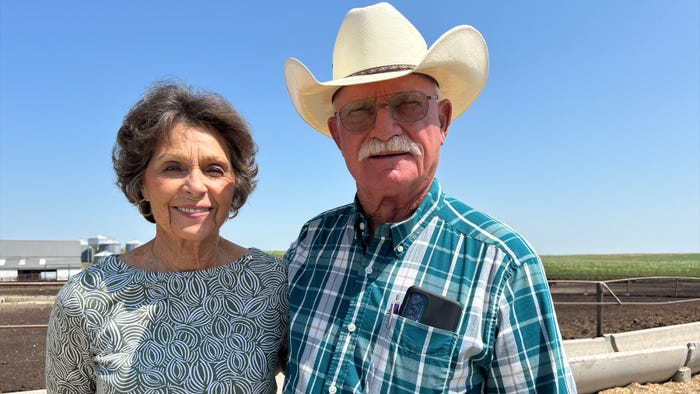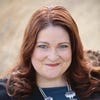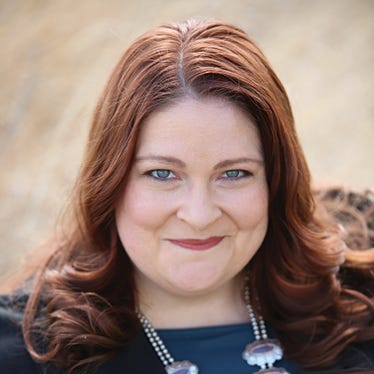
At a Glance
- Ken and Pat Stielow are members of the Class of 2023 Kansas Master Farm Families.
- The family raises Angus, Red Angus and Charolais cattle on land that’s been in the family since the late 1800s.
- Bar S Ranch was in the path of the December 2021 Four County Fire that burned 96,000 acres overnight.
It was 10 days before Christmas in 2021 at the Bar S Ranch, near Paradise, Kan., and severe drought meant there was little chance of a white Christmas. The weatherman warned there could be a windstorm that day, and folks in the area took time to secure their outdoor holiday decorations and lights — just in case.
One spark turned into a large grass fire — and then another, and another — all fed by 100 mph winds. By 3 a.m. Dec. 16, the Four County Fire had whipped through 96,000 acres of Ellis, Osborne, Rooks and Russell counties. It moved fast, and it blazed hot, taking everything in its path. It’s a night that Ken and Pat Stielow will not soon forget.
For them, time can be divided as pre-fire and post-fire.
Before the fire
Ken and Pat married in 1965, and moved to Manhattan, Kan., so Ken could continue his education at Kansas State University, earning his bachelor’s and master’s degrees in agricultural economics. Pat worked at the Kansas Farm Bureau’s headquarters in Manhattan.
After Ken graduated from K-State, the couple moved to Concordia, Kan., where he worked for six years for the Kansas Farm Management Association.
The couple welcomed their son, Christopher, in 1971, and then their daughter, Stephanie, in 1975. It was after Stephanie’s birth that Ken’s father reached out to ask if they wanted to come home to Paradise and ranch.
“My folks were at a point where they were wanting to slow down,” Ken says. He was the only cousin of his generation with an interest in returning to the ranch, and it became an opportunity to take on more family ground and raise cattle. He used his experience with KFMA to learn from other producers and absorb different management styles and strategies that he could implement.
“I wasn’t sure I wanted to return to our family operation during this time, but looking back at it now, these experiences helped me understand some things I needed to learn,” Ken says.
Building a herd
Angus cattle were the breed of choice for Ken’s father, although it was a mostly commercial cow herd with some stocker cattle. While he kept a few registered cows, that registered seedstock side wasn’t really the focus, Ken says. That is, until artificial insemination become much more prevalent on a larger scale.
Larry Corah, who used to lead cow-calf research at K-State, worked with the Stielows in the 1970s and 1980s to implement AI into their breeding program, Ken says.
“We were his experiment farm for a while,” he says. They were able to AI their entire heifer crop, and thus able to use top Angus sires at a more affordable rate.
Ken says their focus was for a terminal calf crop, with any bulls that didn’t make their strict criteria for their production sale getting fed out as steers. They expanded into a Red Angus herd, and then a Charolais herd, all using AI and embryo transfer.
“We’ve designed our business model around producing registered bulls for the commercial cow-calf producer,” Ken says. Bar S cattle have a reputation for hardiness in the pasture, and their calves have a reputation in the feedlot and on the rail.
“We raise cattle designed for longevity, fertility and predictability,” Ken says. Russell County is ranch country, with rough terrain and ever-threatening drought conditions. It calls for a cow that can raise a calf in a low-input management system.
“I don’t know that we really ever thought of ourselves as a purebred operation,” Ken says. “We were just commercial people. And that’s the way we’ve run our cows. Even the registered ones.”
Faithful family
The Stielows have always been a tight family, grounded in faith. But for Ken and Pat, their greatest joy is in their children and grandchildren.
Their son, Chris, was born with Down syndrome, and Ken and Pat leaned on each other and their small rural Kansas community to meet every challenge that was presented in the 1970s and 1980s.
Pat credits neighbors with supporting their family in so many ways. One neighbor taught at a closer school in the district and could help them get Chris to school for his special education classes. Other friends and family supported Chris as he competed in Special Olympics. There wasn’t a place where he wasn’t welcomed with love and acceptance, Pat says.
“We treated him just like any other child,” Pat says. They set expectations for him like any other child, she says.
“And you know, there were some challenges, but all along the way, you know, God’s provided people to encourage us to say, ‘Hey, this is what worked for us,’” Pat says.
Their daughter, Stephanie, found her niche in showing livestock in 4-H, and Pat volunteered as a leader for her club, and served on the County Extension Council and local fair board.
Whatever activities the children did, Pat stepped up to volunteer, and not only to help her own children, but also to give back to the community’s children as well.
“Some kids come from a home that you know, they really needed attention and love, and you can give that,” she says. “I might not have a lot to give, but I can give that.”
After the fire
The Stielows and their neighbors had seen the weather reports of high winds expected that December day, but even to their considered experience, the wind felt different.
With sustained speeds of more than 100 mph, the wind was playing havoc with power lines, some of which sparked fires in the tinder-dry ranch grasses. Those high winds fed the flames and pushed them fast across the land.
Stephanie and her husband, David Dickerson, who live just down the road from the ranch headquarters, were responding to a neighbor’s call for help in getting their horses moved to safety. While they were gone, a fire had started near their house, and when they returned there was nothing left of their home.
The Bar S Ranch headquarters, though, was spared and served as a rallying point for the community in the days that followed as people tried to recover from the wildfire. Pat and neighbors served dozens of community meals out of the ranch kitchen space to volunteers coming to help them recover from the fire.
“The toughest thing we lost that day was we had a set of fall cows over here with embryo calves on them, and the next day we were going to put in another set of embryos, and they were on grass that hadn’t had any rain on it, and we lost them,” Ken says.
Miles of fence and thousands of acres of grazing land were gone. It was tough to just find a place to start.
Contacts in the cattle industry reached out to help them find pasture for surviving cattle, brought hay, donated money to community rebuilding, and even helped Stephanie re-create their herd records. The outpouring of help was monumental, Ken says.
It’s been a little more than two years since that fateful night, and the Stielows have found a new normal. Stephanie and her husband have rebuilt their home that they lost, and the herd has recovered.
And while life was different pre-fire, the tragedy did show them how blessed they were to have so many people come help them recover post-fire. And how they can pass that blessing on to others.
“When tragedies happen, people stick together,” Ken says.
Read more about:
Master FarmersAbout the Author(s)
You May Also Like






